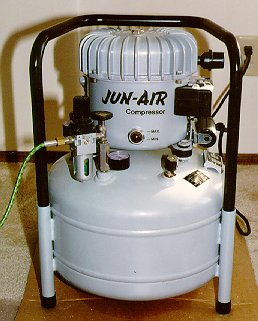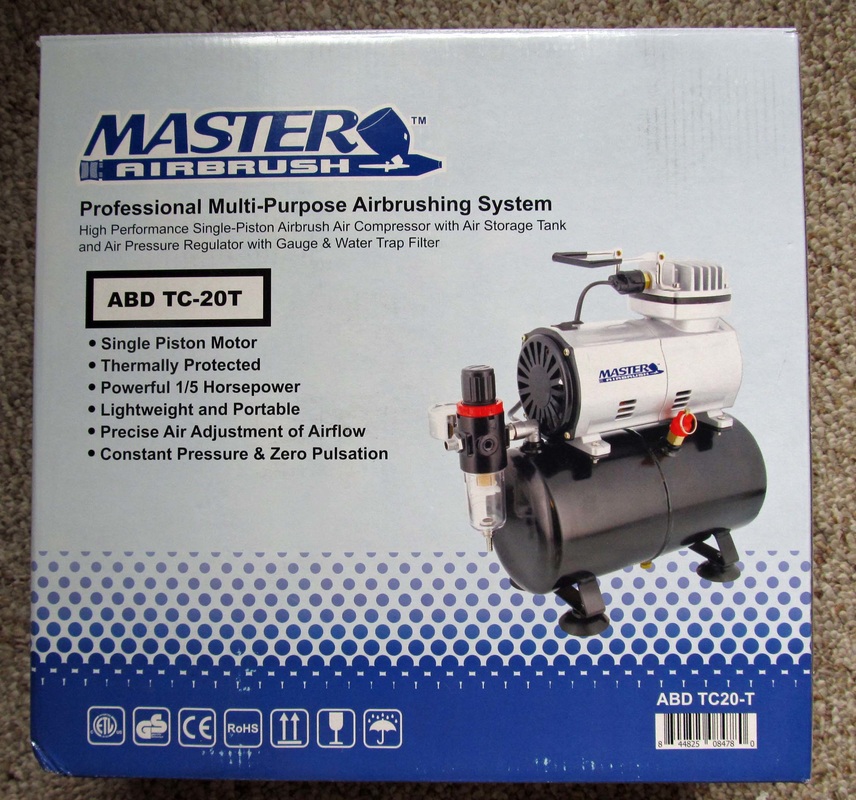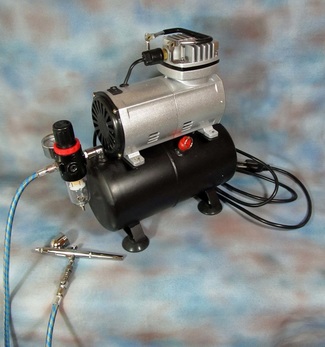Compressors
On this page, I am going to discuss compressors for airbrushing. It’s a tricky subject because it can be complicated, but I have included a link to a really good article that will explain compressors a whole lot better than I ever could.
My very first compressor was a very old, very noisy, very jumpy diaphragm compressor my dad had lurking in the dark recesses of the barn. He’d had it for years and wasn’t using it. I am not sure what he did to it, but it ran (sort of) and I just wanted to start airbrushing RIGHTNOW. I used that for a very short time because it was so loud that I could only use it outside. Oh, and it barely pushed out enough air.
My next compressor was a small Dayton-Speedaire that my dad got from his employer. It turned out to be too small for what his employer needed it for so they sold it to me for $60 (a lot of money way back then and for a "kid" to boot).
My dad, being a handy guy, added an air tank…..a very large, old-fashioned empty fire extinguisher! That proved to be a bit “unportable” and he later changed it out with a smaller used fire extinguisher. I used that set-up for many, many years.
I can’t remember why I ended up buying a new compressor (and selling the old one), but I did.
Because I was a “serious” airbrusher (whatever THAT is – it sounds good, though, eh?) and knew I would be airbrushing for a long time to come, I looked at the higher end compressors. I wanted something that was very quiet and well-built. My search led me to purchasing a compressor often used by dental offices. Meet my Jun-Air:
My very first compressor was a very old, very noisy, very jumpy diaphragm compressor my dad had lurking in the dark recesses of the barn. He’d had it for years and wasn’t using it. I am not sure what he did to it, but it ran (sort of) and I just wanted to start airbrushing RIGHTNOW. I used that for a very short time because it was so loud that I could only use it outside. Oh, and it barely pushed out enough air.
My next compressor was a small Dayton-Speedaire that my dad got from his employer. It turned out to be too small for what his employer needed it for so they sold it to me for $60 (a lot of money way back then and for a "kid" to boot).
My dad, being a handy guy, added an air tank…..a very large, old-fashioned empty fire extinguisher! That proved to be a bit “unportable” and he later changed it out with a smaller used fire extinguisher. I used that set-up for many, many years.
I can’t remember why I ended up buying a new compressor (and selling the old one), but I did.
Because I was a “serious” airbrusher (whatever THAT is – it sounds good, though, eh?) and knew I would be airbrushing for a long time to come, I looked at the higher end compressors. I wanted something that was very quiet and well-built. My search led me to purchasing a compressor often used by dental offices. Meet my Jun-Air:
It put me back about $750 when I bought it in 1995 (today they sell for much, much more). It is the kind of compressor that needs its oil and filter changed regularly, just like a car. In general, that kind of compressor runs quieter and lasts longer than the oil-less compressors. It has been pretty darn reliable, although it needed a hole in the air tank welded (my fault that it happened; I did not faithfully empty any accumulated water after each session) and I sunk in a chunk of change on a routine service kit that replaced parts that wear during use. Overall, I'm pleased with my Jun-Air.
But to be honest, my Jun-Air is really overkill for as much as I airbrush. I would have been just as satisfied with a smaller unit from a less-expensive manufacturer. I really should have just kept my Dayton-Speedaire but you know what they say about hindsight.
My Jun-Air is quiet enough at 45 decibels that I can listen to music or an audiobook while painting. Because it has a 6-gallon air tank, it doesn't run very often, but when it does, I barely notice it.
If you are just starting out and aren’t sure whether or not you will like airbrushing and you don’t want to spend a lot of $$, a smaller but noisier oil-less piston or diaphragm compressor will suffice.
Many places sell such compressors, including eBay and Amazon. You can also buy them from such places as:
Airbrush SuperStore
Coast Airbrush
Dick Blick
Dixie Art & Airbrush
Don't be hesitant to purchase a used compressor from eBay or Craigslist. It seems there are a lot of people out there that thought they might like airbrushing and found out it wasn't for them so they end up getting rid of their barely used equipment via eBay or Craiglist. Just be sure not to buy something that looks dirty or rusty.
If you’ve tried airbrushing and know you really want to stick with it, buy the best compressor you can afford. If you go too cheap on either the airbrush or compressor, chances are good you will run into difficulties and end up disliking airbrushing. YOU will be the person selling the compressor and airbrush on eBay or Craigslist!
Do yourself a favor when buying your compressor and make sure it comes with a regulator/moisture trap combination (or at least a regulator). If not, buy one and put it on yourself. I’ve heard of some people attaching their airbrush hose directly to the compressor (no regulator) and painting with whatever pressure the compressor is producing, but how they manage that is beyond me.
But to be honest, my Jun-Air is really overkill for as much as I airbrush. I would have been just as satisfied with a smaller unit from a less-expensive manufacturer. I really should have just kept my Dayton-Speedaire but you know what they say about hindsight.
My Jun-Air is quiet enough at 45 decibels that I can listen to music or an audiobook while painting. Because it has a 6-gallon air tank, it doesn't run very often, but when it does, I barely notice it.
If you are just starting out and aren’t sure whether or not you will like airbrushing and you don’t want to spend a lot of $$, a smaller but noisier oil-less piston or diaphragm compressor will suffice.
Many places sell such compressors, including eBay and Amazon. You can also buy them from such places as:
Airbrush SuperStore
Coast Airbrush
Dick Blick
Dixie Art & Airbrush
Don't be hesitant to purchase a used compressor from eBay or Craigslist. It seems there are a lot of people out there that thought they might like airbrushing and found out it wasn't for them so they end up getting rid of their barely used equipment via eBay or Craiglist. Just be sure not to buy something that looks dirty or rusty.
If you’ve tried airbrushing and know you really want to stick with it, buy the best compressor you can afford. If you go too cheap on either the airbrush or compressor, chances are good you will run into difficulties and end up disliking airbrushing. YOU will be the person selling the compressor and airbrush on eBay or Craigslist!
Do yourself a favor when buying your compressor and make sure it comes with a regulator/moisture trap combination (or at least a regulator). If not, buy one and put it on yourself. I’ve heard of some people attaching their airbrush hose directly to the compressor (no regulator) and painting with whatever pressure the compressor is producing, but how they manage that is beyond me.
Over the years, I have been asked many times by wannabe airbrushers if the cheapo airbrush and compressor set they found on eBay or Amazon is a good one to start with. My first instinct was to say no, because I have tried those little no-name compressors and found they were so much garbage. But when I wanted to get an inexpensive back-up compressor that was portable that I could also use in the basement for basecoating and priming and perhaps take it with me to live shows for airbrushing demos, I searched eBay for what I thought might be something appropriate (and cheap!) and ended up purchasing this set:
It is a Master airbrush and compressor set, purchased for approximately $125 (including shipping) on eBay from TCP Global, which also has a website here. They sell a lot of different combinations of airbrushes and compressors, but I purchased this one because this compressor has a small tank (meaning it will run less often, which extends the life of the compressor).
I was skeptical about this whole system, but I was pleasantly surprised that the compressor performed better than I expected. The Master airbrush that came with it was so poorly manufactured that I got rid of it. It could barely spray paint at all - a complete piece of junk.
The compressor was able to produce enough pressure to push some fairly thick paint - I had it around 40 psi, which is plenty for normal, everyday model horse painting, especially if you are using properly thinned paints. It does get hot very quickly and I found if I airbrushed too long (longer than a half-hour), it got too hot to run and had to cool down before it would work again. This was a bit disappointing, considering the tank is supposed to prevent overheating, but I decided to make the best of the situation and simply took that as a sign I needed to take a break from airbrushing!
The model of compressor that I purchased is the TC-20T and TCGlobal also has a slightly more powerful and more expensive version in the TC-40T, which also comes with a hose. Either one would be good, entry-level compressors that won't cost you a lot of money. They won't last as long as a better quality, more expensive brands of compressors, but
The bottom line: The Master Airbrush brand compressors TC-20T and TC-40T aren't bad for inexpensive compressors and would be good for those that airbrush occasionally and/or don't airbrush for long periods of time.
See the compressors TCP Global offers at: http://www.tcpglobal.com/
I was skeptical about this whole system, but I was pleasantly surprised that the compressor performed better than I expected. The Master airbrush that came with it was so poorly manufactured that I got rid of it. It could barely spray paint at all - a complete piece of junk.
The compressor was able to produce enough pressure to push some fairly thick paint - I had it around 40 psi, which is plenty for normal, everyday model horse painting, especially if you are using properly thinned paints. It does get hot very quickly and I found if I airbrushed too long (longer than a half-hour), it got too hot to run and had to cool down before it would work again. This was a bit disappointing, considering the tank is supposed to prevent overheating, but I decided to make the best of the situation and simply took that as a sign I needed to take a break from airbrushing!
The model of compressor that I purchased is the TC-20T and TCGlobal also has a slightly more powerful and more expensive version in the TC-40T, which also comes with a hose. Either one would be good, entry-level compressors that won't cost you a lot of money. They won't last as long as a better quality, more expensive brands of compressors, but
The bottom line: The Master Airbrush brand compressors TC-20T and TC-40T aren't bad for inexpensive compressors and would be good for those that airbrush occasionally and/or don't airbrush for long periods of time.
See the compressors TCP Global offers at: http://www.tcpglobal.com/




